Tax Law and Timber Cutting Case
VerifiedAdded on 2020/04/01
|12
|1837
|37
AI Summary
This assignment delves into the complexities of Australian tax law through a case study involving Bill, an individual who sells timber from his land. It examines relevant legislation like subsection 6(1) of the ITAA 1936 and TR 95/6, focusing on primary production, forestry operations, and royalty income recognition under section 26(f). The analysis draws upon case law like McCauley v FC of T to illustrate legal precedents. Ultimately, the assignment concludes by determining the taxability of Bill's income from timber sales.
Contribute Materials
Your contribution can guide someone’s learning journey. Share your
documents today.
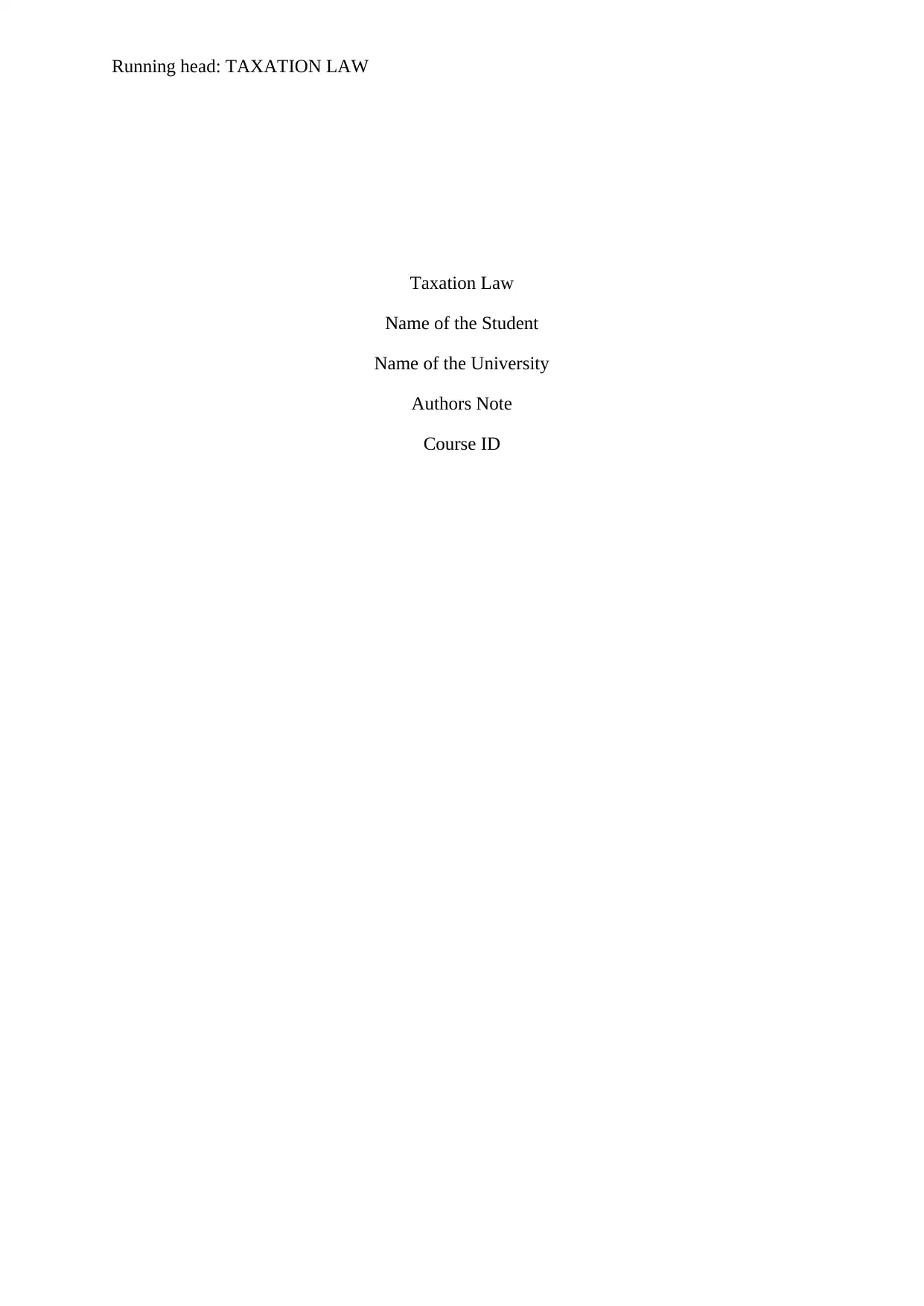
Running head: TAXATION LAW
Taxation Law
Name of the Student
Name of the University
Authors Note
Course ID
Taxation Law
Name of the Student
Name of the University
Authors Note
Course ID
Secure Best Marks with AI Grader
Need help grading? Try our AI Grader for instant feedback on your assignments.
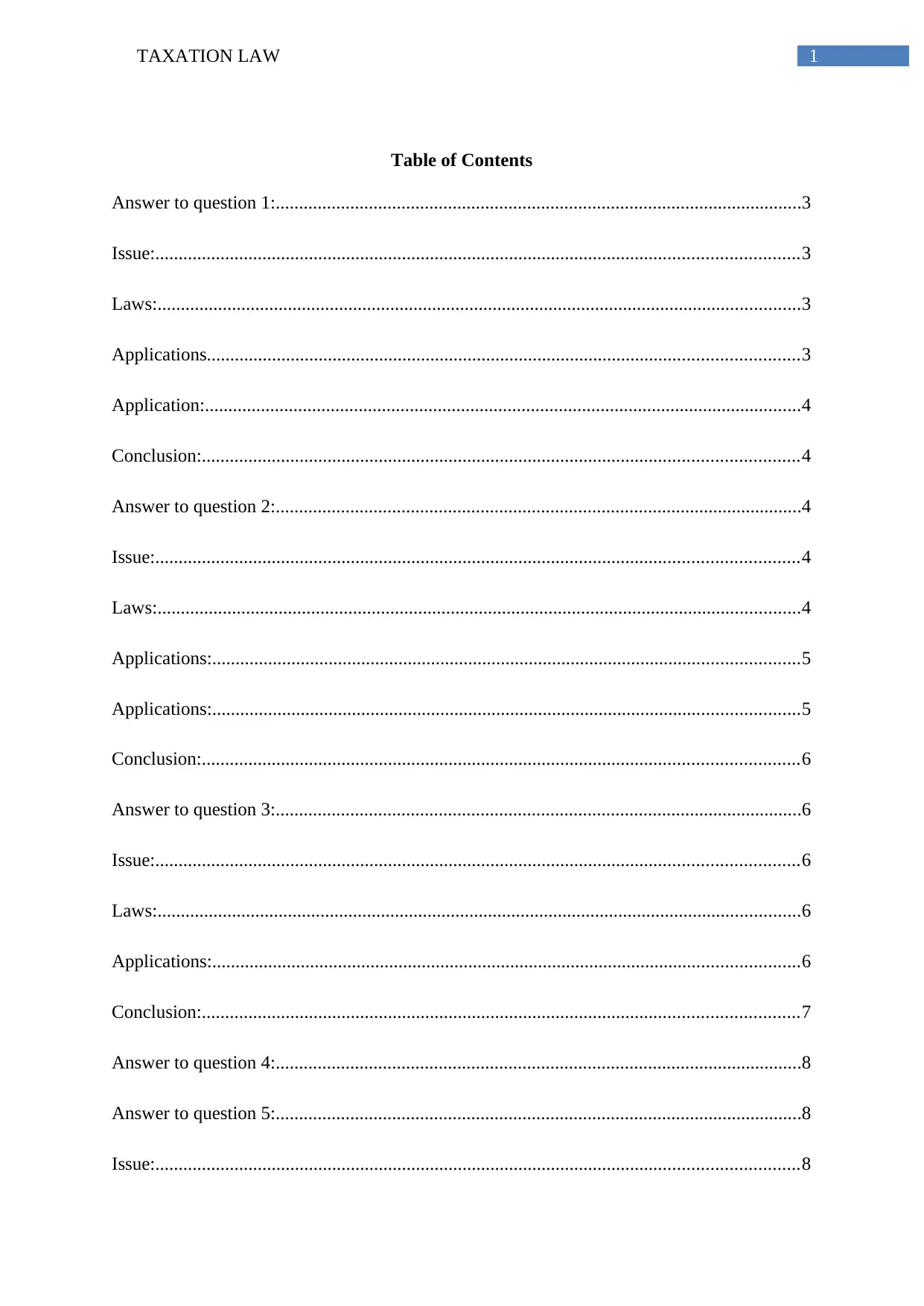
1TAXATION LAW
Table of Contents
Answer to question 1:.................................................................................................................3
Issue:..........................................................................................................................................3
Laws:..........................................................................................................................................3
Applications...............................................................................................................................3
Application:................................................................................................................................4
Conclusion:................................................................................................................................4
Answer to question 2:.................................................................................................................4
Issue:..........................................................................................................................................4
Laws:..........................................................................................................................................4
Applications:..............................................................................................................................5
Applications:..............................................................................................................................5
Conclusion:................................................................................................................................6
Answer to question 3:.................................................................................................................6
Issue:..........................................................................................................................................6
Laws:..........................................................................................................................................6
Applications:..............................................................................................................................6
Conclusion:................................................................................................................................7
Answer to question 4:.................................................................................................................8
Answer to question 5:.................................................................................................................8
Issue:..........................................................................................................................................8
Table of Contents
Answer to question 1:.................................................................................................................3
Issue:..........................................................................................................................................3
Laws:..........................................................................................................................................3
Applications...............................................................................................................................3
Application:................................................................................................................................4
Conclusion:................................................................................................................................4
Answer to question 2:.................................................................................................................4
Issue:..........................................................................................................................................4
Laws:..........................................................................................................................................4
Applications:..............................................................................................................................5
Applications:..............................................................................................................................5
Conclusion:................................................................................................................................6
Answer to question 3:.................................................................................................................6
Issue:..........................................................................................................................................6
Laws:..........................................................................................................................................6
Applications:..............................................................................................................................6
Conclusion:................................................................................................................................7
Answer to question 4:.................................................................................................................8
Answer to question 5:.................................................................................................................8
Issue:..........................................................................................................................................8
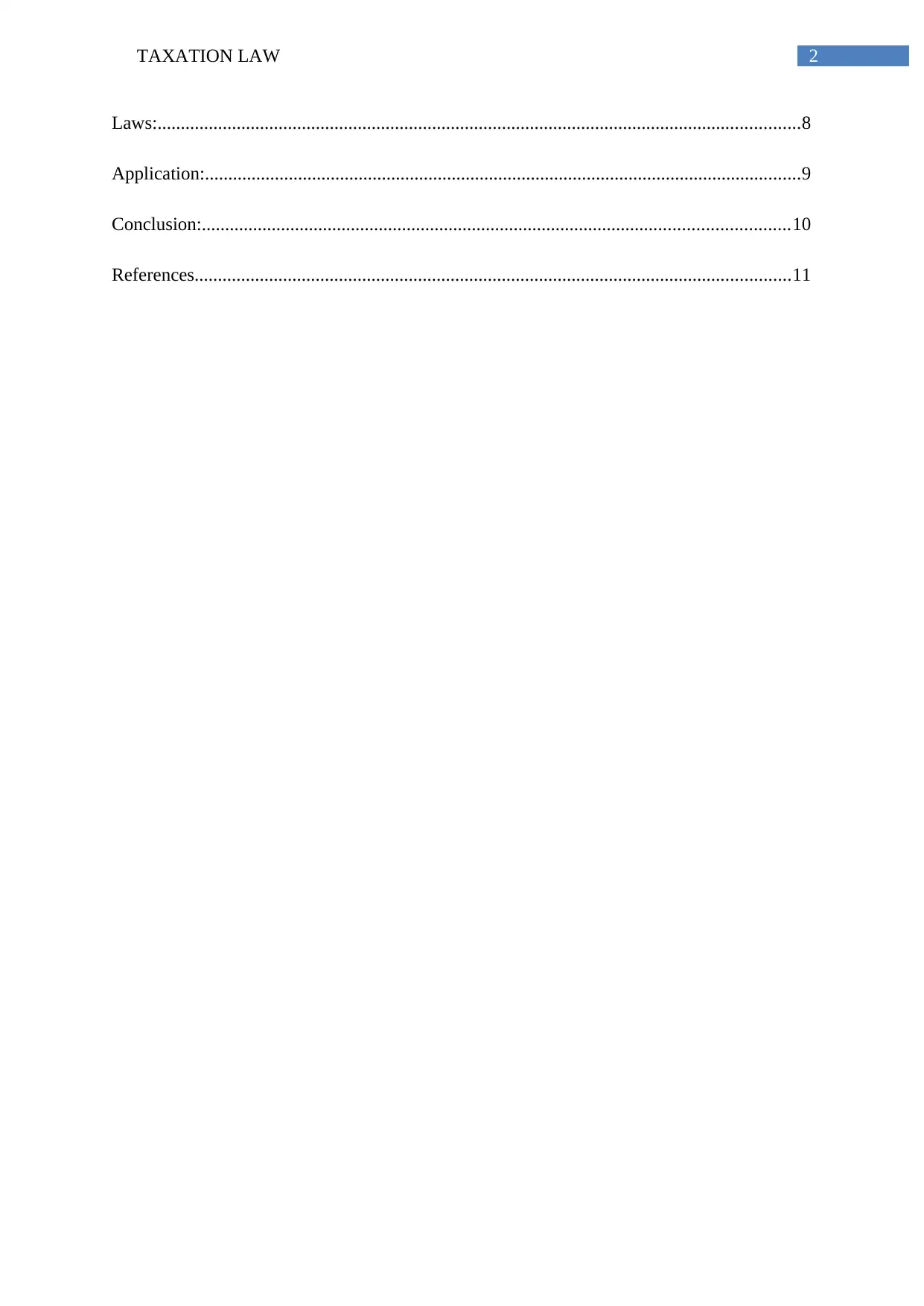
2TAXATION LAW
Laws:..........................................................................................................................................8
Application:................................................................................................................................9
Conclusion:..............................................................................................................................10
References................................................................................................................................11
Laws:..........................................................................................................................................8
Application:................................................................................................................................9
Conclusion:..............................................................................................................................10
References................................................................................................................................11
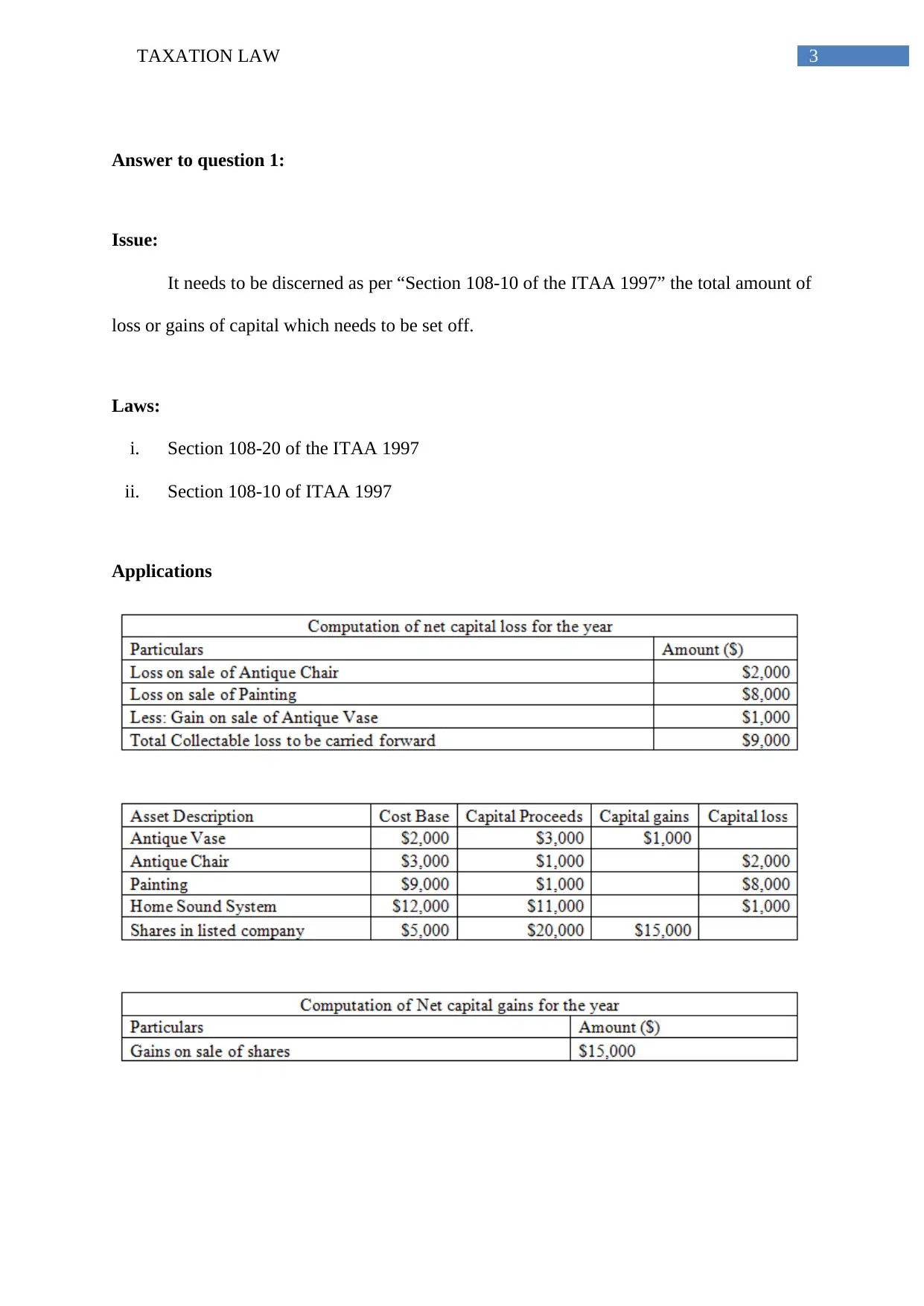
3TAXATION LAW
Answer to question 1:
Issue:
It needs to be discerned as per “Section 108-10 of the ITAA 1997” the total amount of
loss or gains of capital which needs to be set off.
Laws:
i. Section 108-20 of the ITAA 1997
ii. Section 108-10 of ITAA 1997
Applications
Answer to question 1:
Issue:
It needs to be discerned as per “Section 108-10 of the ITAA 1997” the total amount of
loss or gains of capital which needs to be set off.
Laws:
i. Section 108-20 of the ITAA 1997
ii. Section 108-10 of ITAA 1997
Applications
Secure Best Marks with AI Grader
Need help grading? Try our AI Grader for instant feedback on your assignments.
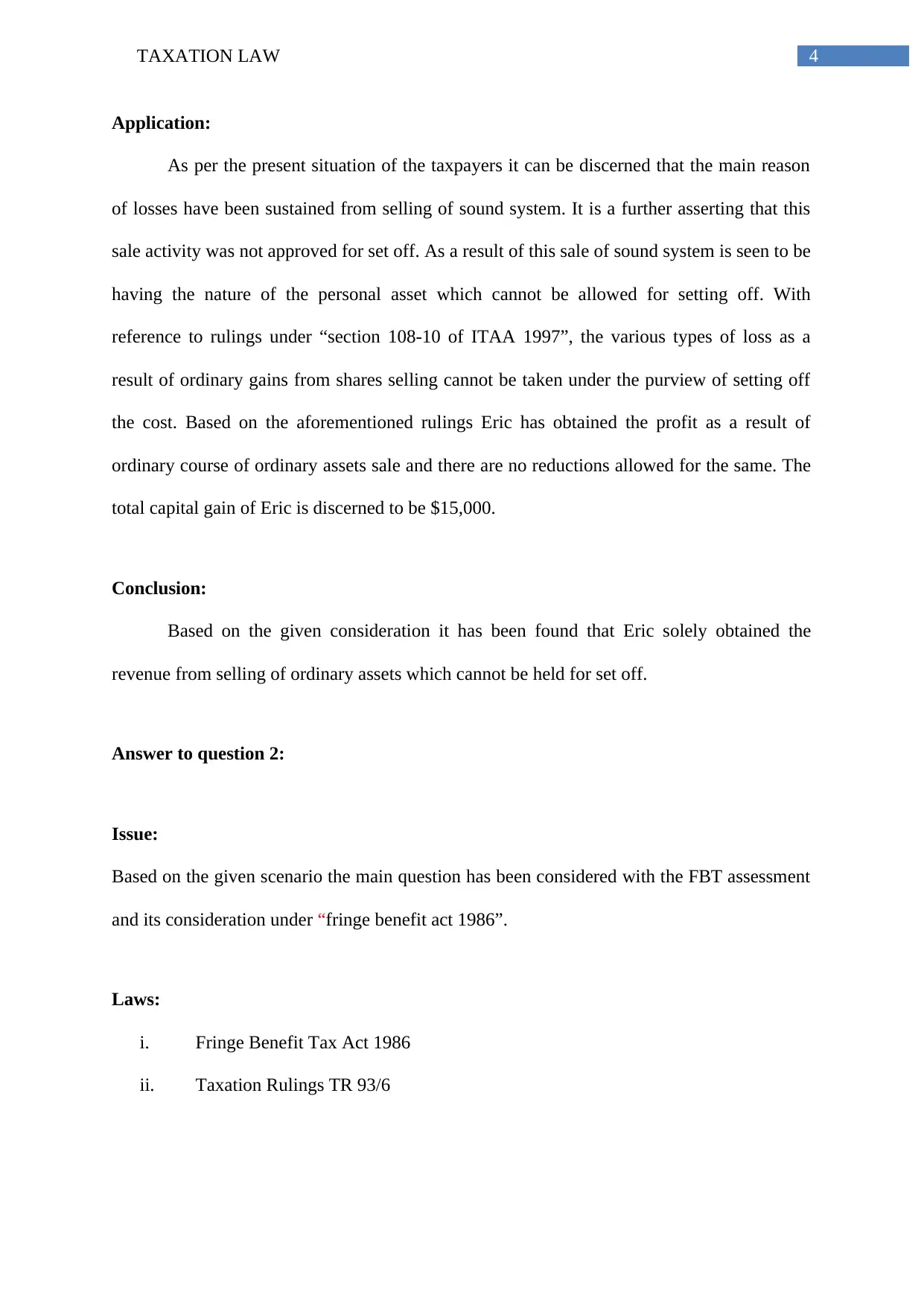
4TAXATION LAW
Application:
As per the present situation of the taxpayers it can be discerned that the main reason
of losses have been sustained from selling of sound system. It is a further asserting that this
sale activity was not approved for set off. As a result of this sale of sound system is seen to be
having the nature of the personal asset which cannot be allowed for setting off. With
reference to rulings under “section 108-10 of ITAA 1997”, the various types of loss as a
result of ordinary gains from shares selling cannot be taken under the purview of setting off
the cost. Based on the aforementioned rulings Eric has obtained the profit as a result of
ordinary course of ordinary assets sale and there are no reductions allowed for the same. The
total capital gain of Eric is discerned to be $15,000.
Conclusion:
Based on the given consideration it has been found that Eric solely obtained the
revenue from selling of ordinary assets which cannot be held for set off.
Answer to question 2:
Issue:
Based on the given scenario the main question has been considered with the FBT assessment
and its consideration under “fringe benefit act 1986”.
Laws:
i. Fringe Benefit Tax Act 1986
ii. Taxation Rulings TR 93/6
Application:
As per the present situation of the taxpayers it can be discerned that the main reason
of losses have been sustained from selling of sound system. It is a further asserting that this
sale activity was not approved for set off. As a result of this sale of sound system is seen to be
having the nature of the personal asset which cannot be allowed for setting off. With
reference to rulings under “section 108-10 of ITAA 1997”, the various types of loss as a
result of ordinary gains from shares selling cannot be taken under the purview of setting off
the cost. Based on the aforementioned rulings Eric has obtained the profit as a result of
ordinary course of ordinary assets sale and there are no reductions allowed for the same. The
total capital gain of Eric is discerned to be $15,000.
Conclusion:
Based on the given consideration it has been found that Eric solely obtained the
revenue from selling of ordinary assets which cannot be held for set off.
Answer to question 2:
Issue:
Based on the given scenario the main question has been considered with the FBT assessment
and its consideration under “fringe benefit act 1986”.
Laws:
i. Fringe Benefit Tax Act 1986
ii. Taxation Rulings TR 93/6
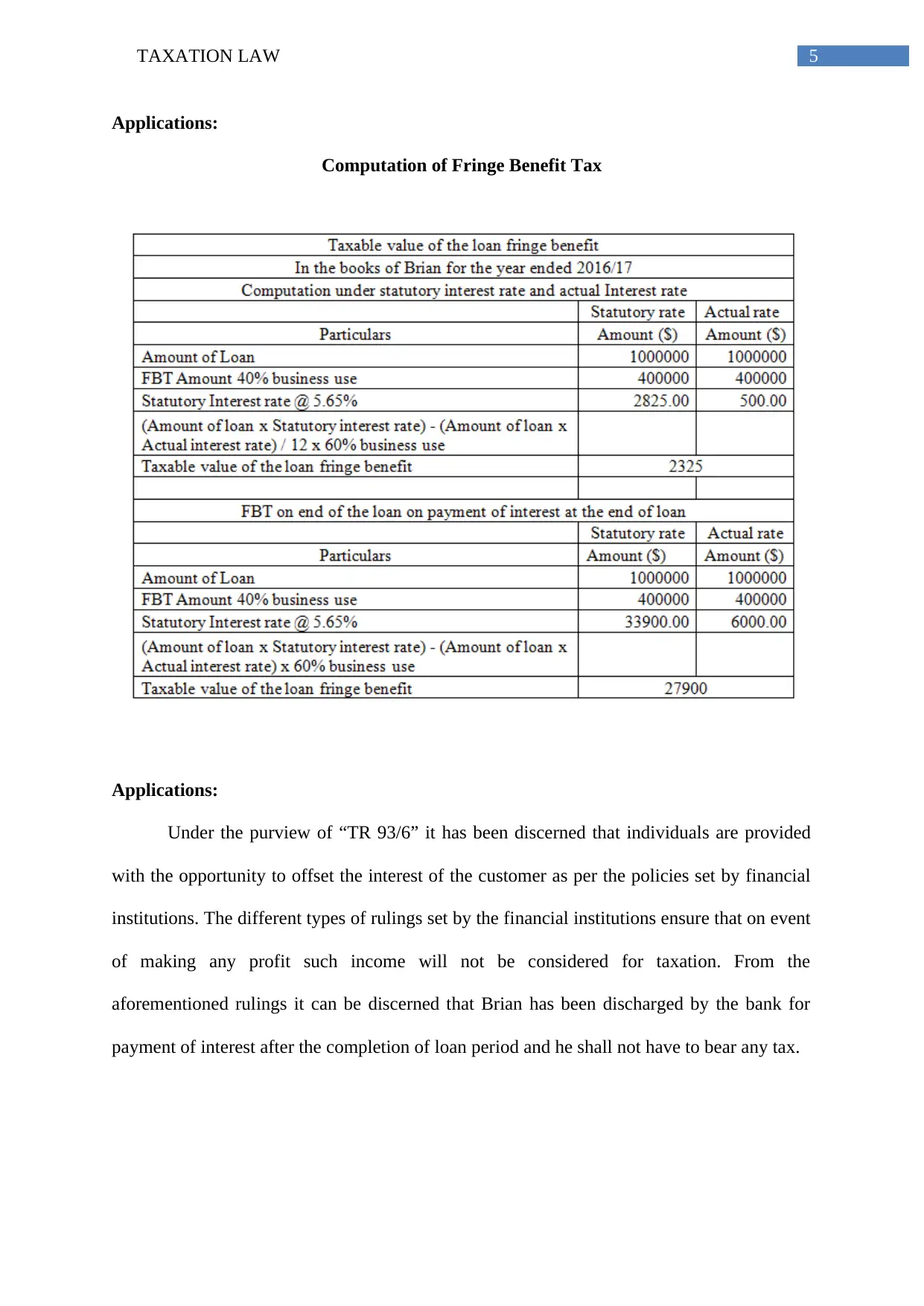
5TAXATION LAW
Applications:
Computation of Fringe Benefit Tax
Applications:
Under the purview of “TR 93/6” it has been discerned that individuals are provided
with the opportunity to offset the interest of the customer as per the policies set by financial
institutions. The different types of rulings set by the financial institutions ensure that on event
of making any profit such income will not be considered for taxation. From the
aforementioned rulings it can be discerned that Brian has been discharged by the bank for
payment of interest after the completion of loan period and he shall not have to bear any tax.
Applications:
Computation of Fringe Benefit Tax
Applications:
Under the purview of “TR 93/6” it has been discerned that individuals are provided
with the opportunity to offset the interest of the customer as per the policies set by financial
institutions. The different types of rulings set by the financial institutions ensure that on event
of making any profit such income will not be considered for taxation. From the
aforementioned rulings it can be discerned that Brian has been discharged by the bank for
payment of interest after the completion of loan period and he shall not have to bear any tax.
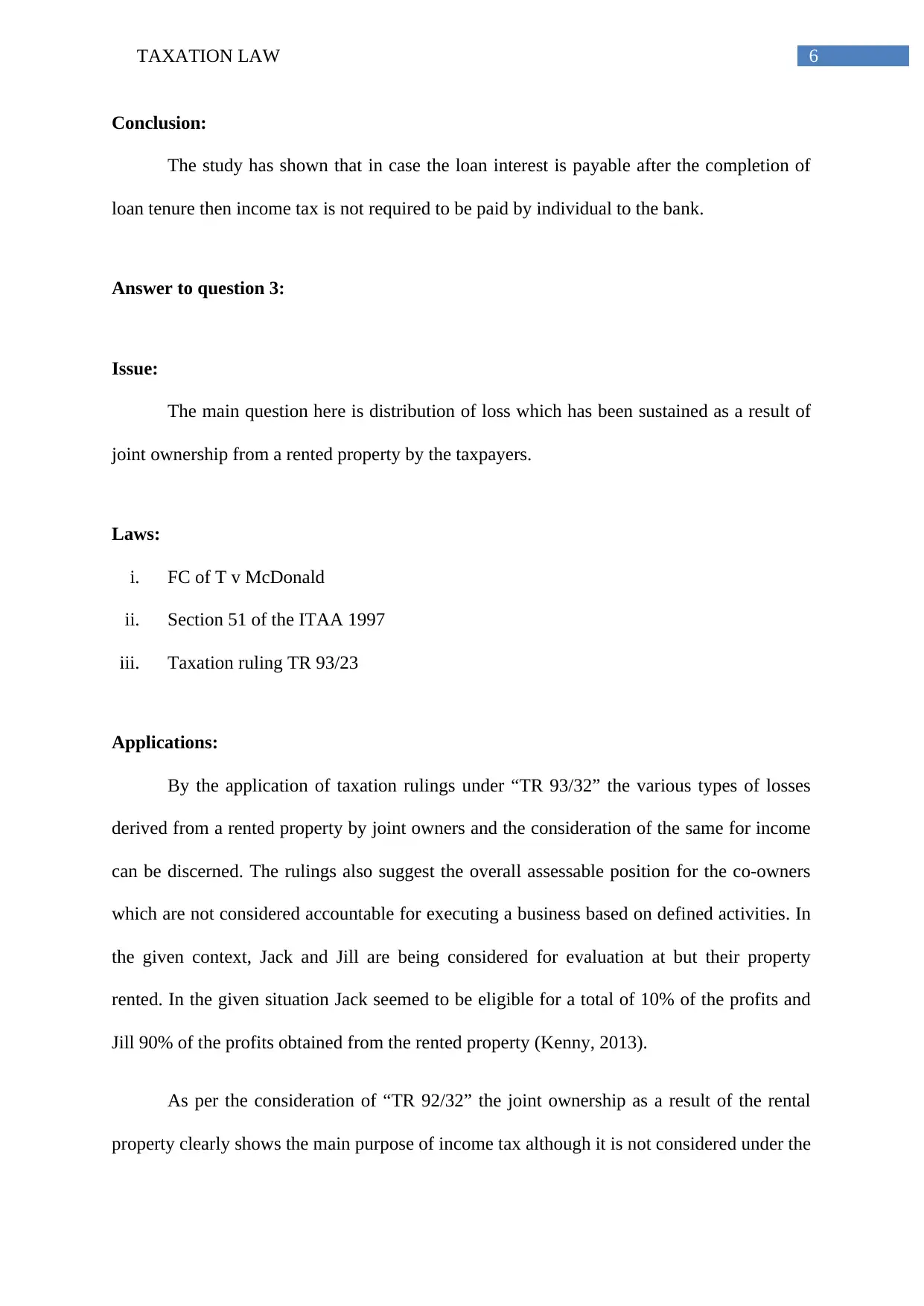
6TAXATION LAW
Conclusion:
The study has shown that in case the loan interest is payable after the completion of
loan tenure then income tax is not required to be paid by individual to the bank.
Answer to question 3:
Issue:
The main question here is distribution of loss which has been sustained as a result of
joint ownership from a rented property by the taxpayers.
Laws:
i. FC of T v McDonald
ii. Section 51 of the ITAA 1997
iii. Taxation ruling TR 93/23
Applications:
By the application of taxation rulings under “TR 93/32” the various types of losses
derived from a rented property by joint owners and the consideration of the same for income
can be discerned. The rulings also suggest the overall assessable position for the co-owners
which are not considered accountable for executing a business based on defined activities. In
the given context, Jack and Jill are being considered for evaluation at but their property
rented. In the given situation Jack seemed to be eligible for a total of 10% of the profits and
Jill 90% of the profits obtained from the rented property (Kenny, 2013).
As per the consideration of “TR 92/32” the joint ownership as a result of the rental
property clearly shows the main purpose of income tax although it is not considered under the
Conclusion:
The study has shown that in case the loan interest is payable after the completion of
loan tenure then income tax is not required to be paid by individual to the bank.
Answer to question 3:
Issue:
The main question here is distribution of loss which has been sustained as a result of
joint ownership from a rented property by the taxpayers.
Laws:
i. FC of T v McDonald
ii. Section 51 of the ITAA 1997
iii. Taxation ruling TR 93/23
Applications:
By the application of taxation rulings under “TR 93/32” the various types of losses
derived from a rented property by joint owners and the consideration of the same for income
can be discerned. The rulings also suggest the overall assessable position for the co-owners
which are not considered accountable for executing a business based on defined activities. In
the given context, Jack and Jill are being considered for evaluation at but their property
rented. In the given situation Jack seemed to be eligible for a total of 10% of the profits and
Jill 90% of the profits obtained from the rented property (Kenny, 2013).
As per the consideration of “TR 92/32” the joint ownership as a result of the rental
property clearly shows the main purpose of income tax although it is not considered under the
Paraphrase This Document
Need a fresh take? Get an instant paraphrase of this document with our AI Paraphraser
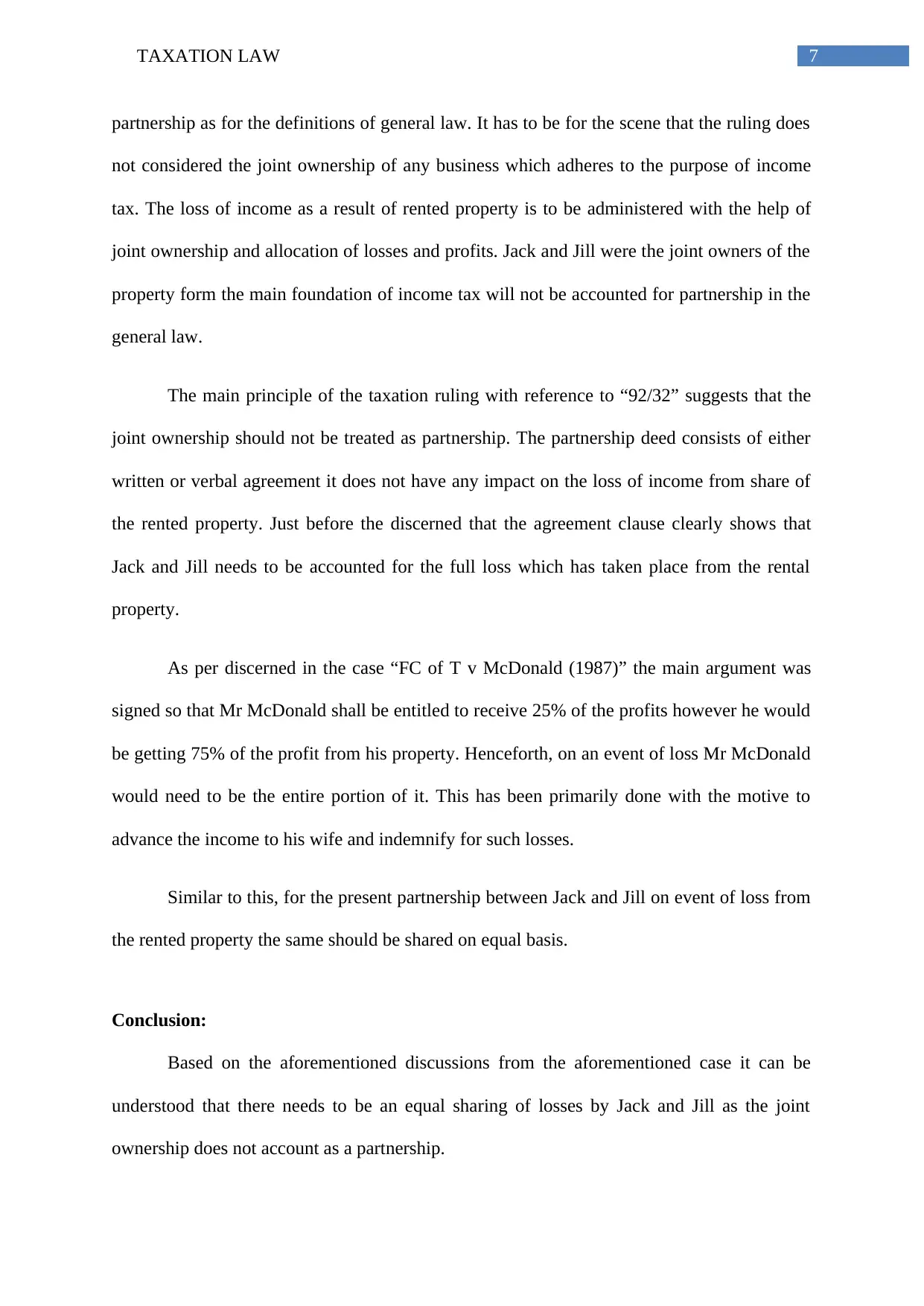
7TAXATION LAW
partnership as for the definitions of general law. It has to be for the scene that the ruling does
not considered the joint ownership of any business which adheres to the purpose of income
tax. The loss of income as a result of rented property is to be administered with the help of
joint ownership and allocation of losses and profits. Jack and Jill were the joint owners of the
property form the main foundation of income tax will not be accounted for partnership in the
general law.
The main principle of the taxation ruling with reference to “92/32” suggests that the
joint ownership should not be treated as partnership. The partnership deed consists of either
written or verbal agreement it does not have any impact on the loss of income from share of
the rented property. Just before the discerned that the agreement clause clearly shows that
Jack and Jill needs to be accounted for the full loss which has taken place from the rental
property.
As per discerned in the case “FC of T v McDonald (1987)” the main argument was
signed so that Mr McDonald shall be entitled to receive 25% of the profits however he would
be getting 75% of the profit from his property. Henceforth, on an event of loss Mr McDonald
would need to be the entire portion of it. This has been primarily done with the motive to
advance the income to his wife and indemnify for such losses.
Similar to this, for the present partnership between Jack and Jill on event of loss from
the rented property the same should be shared on equal basis.
Conclusion:
Based on the aforementioned discussions from the aforementioned case it can be
understood that there needs to be an equal sharing of losses by Jack and Jill as the joint
ownership does not account as a partnership.
partnership as for the definitions of general law. It has to be for the scene that the ruling does
not considered the joint ownership of any business which adheres to the purpose of income
tax. The loss of income as a result of rented property is to be administered with the help of
joint ownership and allocation of losses and profits. Jack and Jill were the joint owners of the
property form the main foundation of income tax will not be accounted for partnership in the
general law.
The main principle of the taxation ruling with reference to “92/32” suggests that the
joint ownership should not be treated as partnership. The partnership deed consists of either
written or verbal agreement it does not have any impact on the loss of income from share of
the rented property. Just before the discerned that the agreement clause clearly shows that
Jack and Jill needs to be accounted for the full loss which has taken place from the rental
property.
As per discerned in the case “FC of T v McDonald (1987)” the main argument was
signed so that Mr McDonald shall be entitled to receive 25% of the profits however he would
be getting 75% of the profit from his property. Henceforth, on an event of loss Mr McDonald
would need to be the entire portion of it. This has been primarily done with the motive to
advance the income to his wife and indemnify for such losses.
Similar to this, for the present partnership between Jack and Jill on event of loss from
the rented property the same should be shared on equal basis.
Conclusion:
Based on the aforementioned discussions from the aforementioned case it can be
understood that there needs to be an equal sharing of losses by Jack and Jill as the joint
ownership does not account as a partnership.
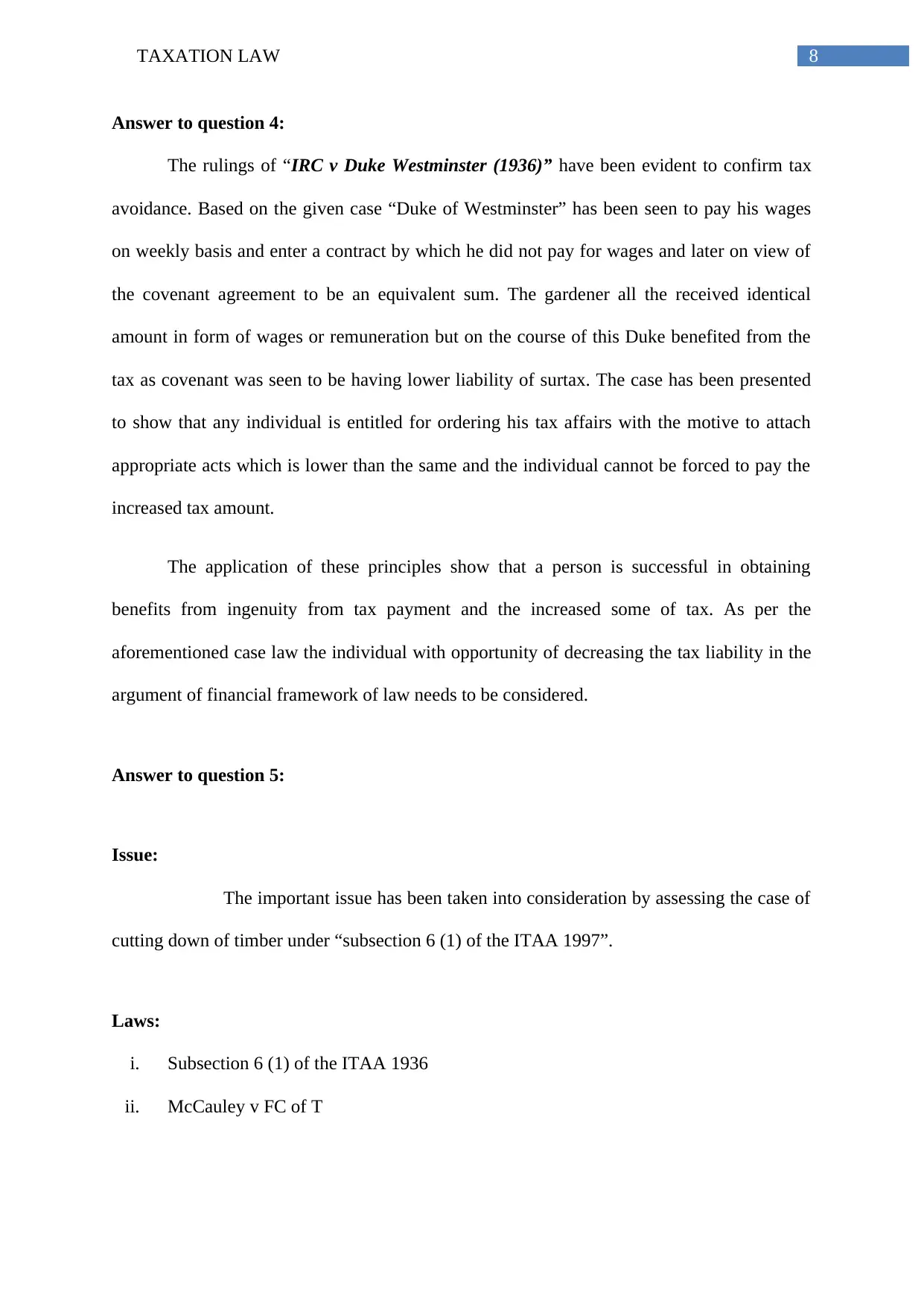
8TAXATION LAW
Answer to question 4:
The rulings of “IRC v Duke Westminster (1936)” have been evident to confirm tax
avoidance. Based on the given case “Duke of Westminster” has been seen to pay his wages
on weekly basis and enter a contract by which he did not pay for wages and later on view of
the covenant agreement to be an equivalent sum. The gardener all the received identical
amount in form of wages or remuneration but on the course of this Duke benefited from the
tax as covenant was seen to be having lower liability of surtax. The case has been presented
to show that any individual is entitled for ordering his tax affairs with the motive to attach
appropriate acts which is lower than the same and the individual cannot be forced to pay the
increased tax amount.
The application of these principles show that a person is successful in obtaining
benefits from ingenuity from tax payment and the increased some of tax. As per the
aforementioned case law the individual with opportunity of decreasing the tax liability in the
argument of financial framework of law needs to be considered.
Answer to question 5:
Issue:
The important issue has been taken into consideration by assessing the case of
cutting down of timber under “subsection 6 (1) of the ITAA 1997”.
Laws:
i. Subsection 6 (1) of the ITAA 1936
ii. McCauley v FC of T
Answer to question 4:
The rulings of “IRC v Duke Westminster (1936)” have been evident to confirm tax
avoidance. Based on the given case “Duke of Westminster” has been seen to pay his wages
on weekly basis and enter a contract by which he did not pay for wages and later on view of
the covenant agreement to be an equivalent sum. The gardener all the received identical
amount in form of wages or remuneration but on the course of this Duke benefited from the
tax as covenant was seen to be having lower liability of surtax. The case has been presented
to show that any individual is entitled for ordering his tax affairs with the motive to attach
appropriate acts which is lower than the same and the individual cannot be forced to pay the
increased tax amount.
The application of these principles show that a person is successful in obtaining
benefits from ingenuity from tax payment and the increased some of tax. As per the
aforementioned case law the individual with opportunity of decreasing the tax liability in the
argument of financial framework of law needs to be considered.
Answer to question 5:
Issue:
The important issue has been taken into consideration by assessing the case of
cutting down of timber under “subsection 6 (1) of the ITAA 1997”.
Laws:
i. Subsection 6 (1) of the ITAA 1936
ii. McCauley v FC of T
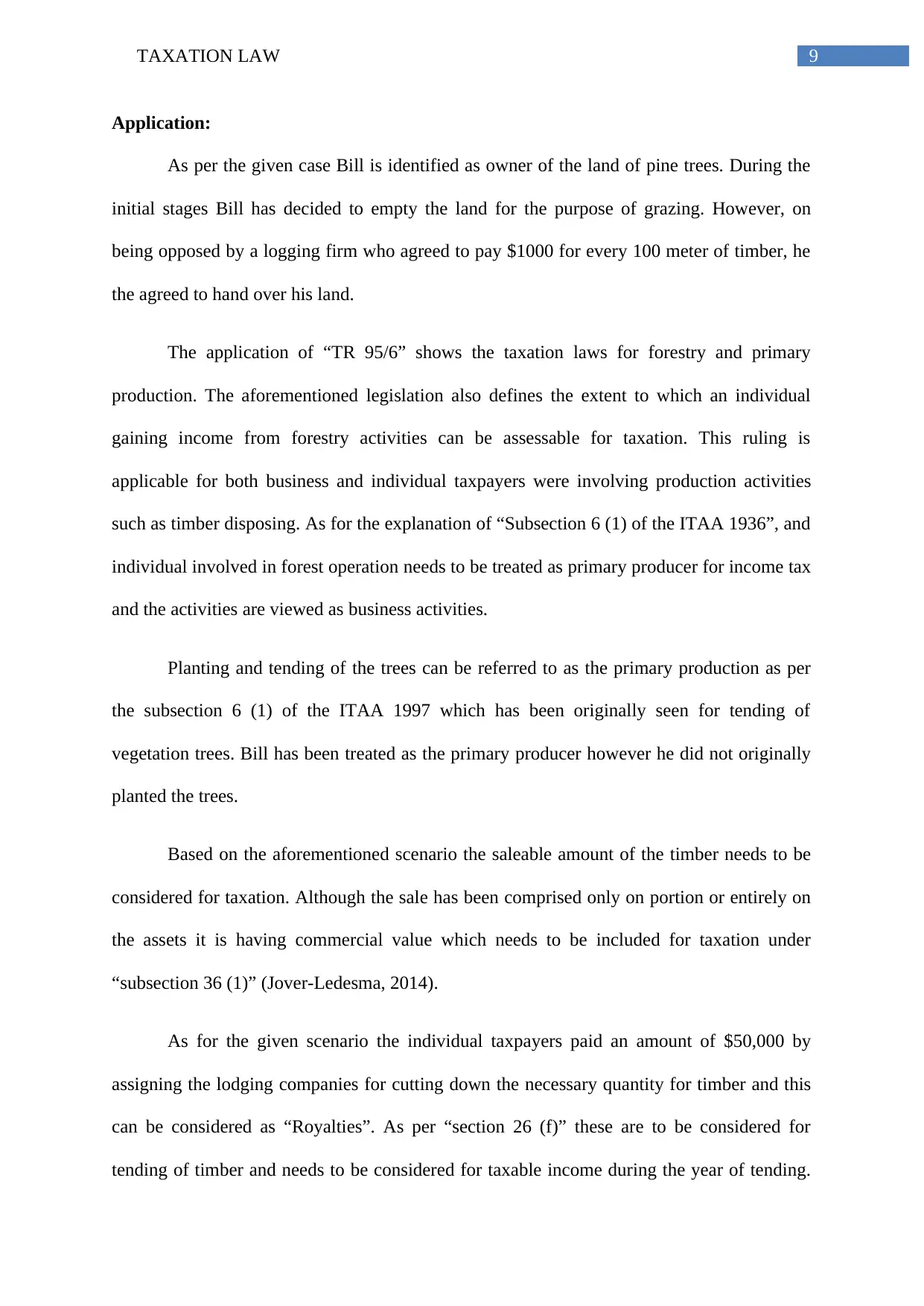
9TAXATION LAW
Application:
As per the given case Bill is identified as owner of the land of pine trees. During the
initial stages Bill has decided to empty the land for the purpose of grazing. However, on
being opposed by a logging firm who agreed to pay $1000 for every 100 meter of timber, he
the agreed to hand over his land.
The application of “TR 95/6” shows the taxation laws for forestry and primary
production. The aforementioned legislation also defines the extent to which an individual
gaining income from forestry activities can be assessable for taxation. This ruling is
applicable for both business and individual taxpayers were involving production activities
such as timber disposing. As for the explanation of “Subsection 6 (1) of the ITAA 1936”, and
individual involved in forest operation needs to be treated as primary producer for income tax
and the activities are viewed as business activities.
Planting and tending of the trees can be referred to as the primary production as per
the subsection 6 (1) of the ITAA 1997 which has been originally seen for tending of
vegetation trees. Bill has been treated as the primary producer however he did not originally
planted the trees.
Based on the aforementioned scenario the saleable amount of the timber needs to be
considered for taxation. Although the sale has been comprised only on portion or entirely on
the assets it is having commercial value which needs to be included for taxation under
“subsection 36 (1)” (Jover-Ledesma, 2014).
As for the given scenario the individual taxpayers paid an amount of $50,000 by
assigning the lodging companies for cutting down the necessary quantity for timber and this
can be considered as “Royalties”. As per “section 26 (f)” these are to be considered for
tending of timber and needs to be considered for taxable income during the year of tending.
Application:
As per the given case Bill is identified as owner of the land of pine trees. During the
initial stages Bill has decided to empty the land for the purpose of grazing. However, on
being opposed by a logging firm who agreed to pay $1000 for every 100 meter of timber, he
the agreed to hand over his land.
The application of “TR 95/6” shows the taxation laws for forestry and primary
production. The aforementioned legislation also defines the extent to which an individual
gaining income from forestry activities can be assessable for taxation. This ruling is
applicable for both business and individual taxpayers were involving production activities
such as timber disposing. As for the explanation of “Subsection 6 (1) of the ITAA 1936”, and
individual involved in forest operation needs to be treated as primary producer for income tax
and the activities are viewed as business activities.
Planting and tending of the trees can be referred to as the primary production as per
the subsection 6 (1) of the ITAA 1997 which has been originally seen for tending of
vegetation trees. Bill has been treated as the primary producer however he did not originally
planted the trees.
Based on the aforementioned scenario the saleable amount of the timber needs to be
considered for taxation. Although the sale has been comprised only on portion or entirely on
the assets it is having commercial value which needs to be included for taxation under
“subsection 36 (1)” (Jover-Ledesma, 2014).
As for the given scenario the individual taxpayers paid an amount of $50,000 by
assigning the lodging companies for cutting down the necessary quantity for timber and this
can be considered as “Royalties”. As per “section 26 (f)” these are to be considered for
tending of timber and needs to be considered for taxable income during the year of tending.
Secure Best Marks with AI Grader
Need help grading? Try our AI Grader for instant feedback on your assignments.
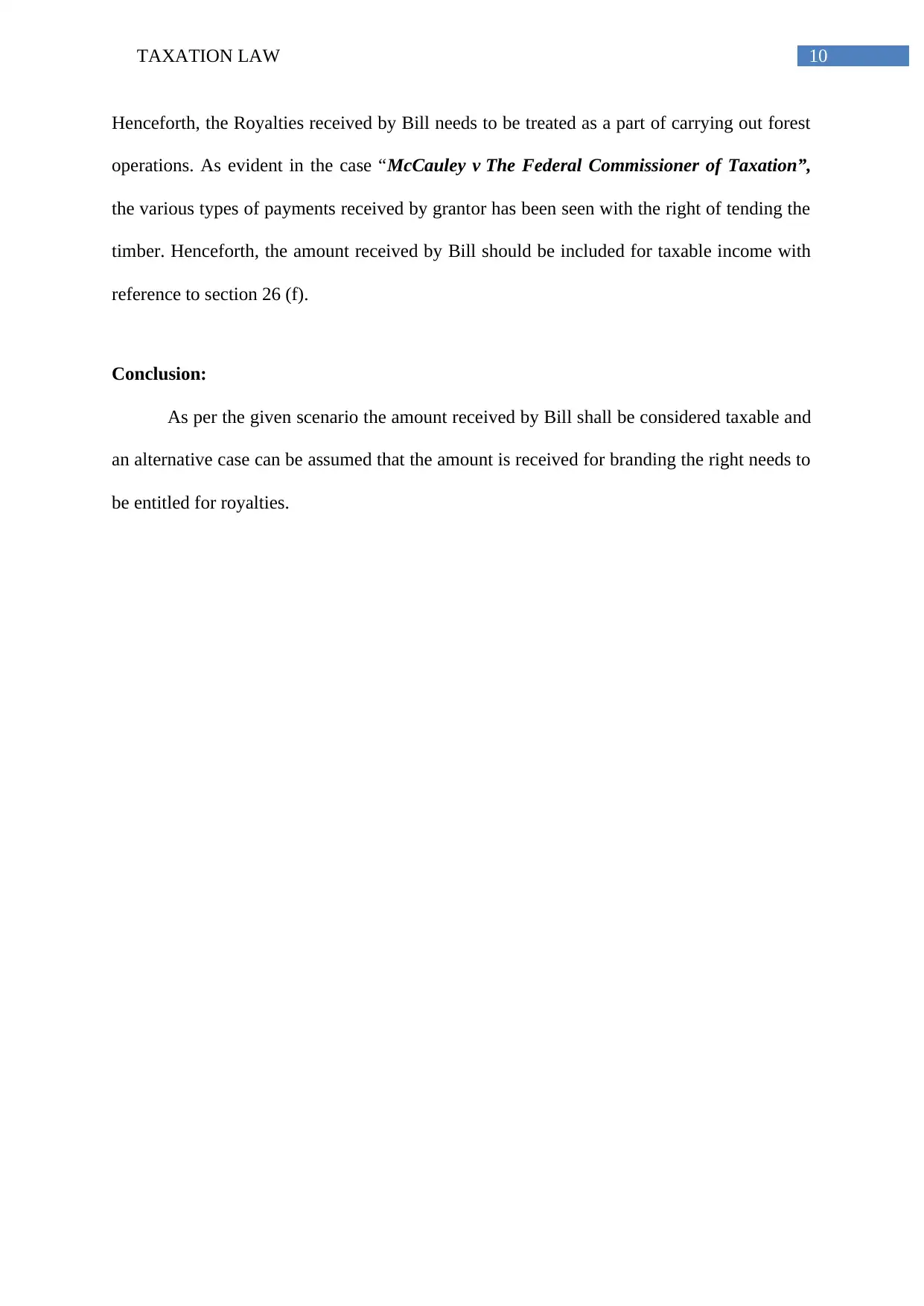
10TAXATION LAW
Henceforth, the Royalties received by Bill needs to be treated as a part of carrying out forest
operations. As evident in the case “McCauley v The Federal Commissioner of Taxation”,
the various types of payments received by grantor has been seen with the right of tending the
timber. Henceforth, the amount received by Bill should be included for taxable income with
reference to section 26 (f).
Conclusion:
As per the given scenario the amount received by Bill shall be considered taxable and
an alternative case can be assumed that the amount is received for branding the right needs to
be entitled for royalties.
Henceforth, the Royalties received by Bill needs to be treated as a part of carrying out forest
operations. As evident in the case “McCauley v The Federal Commissioner of Taxation”,
the various types of payments received by grantor has been seen with the right of tending the
timber. Henceforth, the amount received by Bill should be included for taxable income with
reference to section 26 (f).
Conclusion:
As per the given scenario the amount received by Bill shall be considered taxable and
an alternative case can be assumed that the amount is received for branding the right needs to
be entitled for royalties.
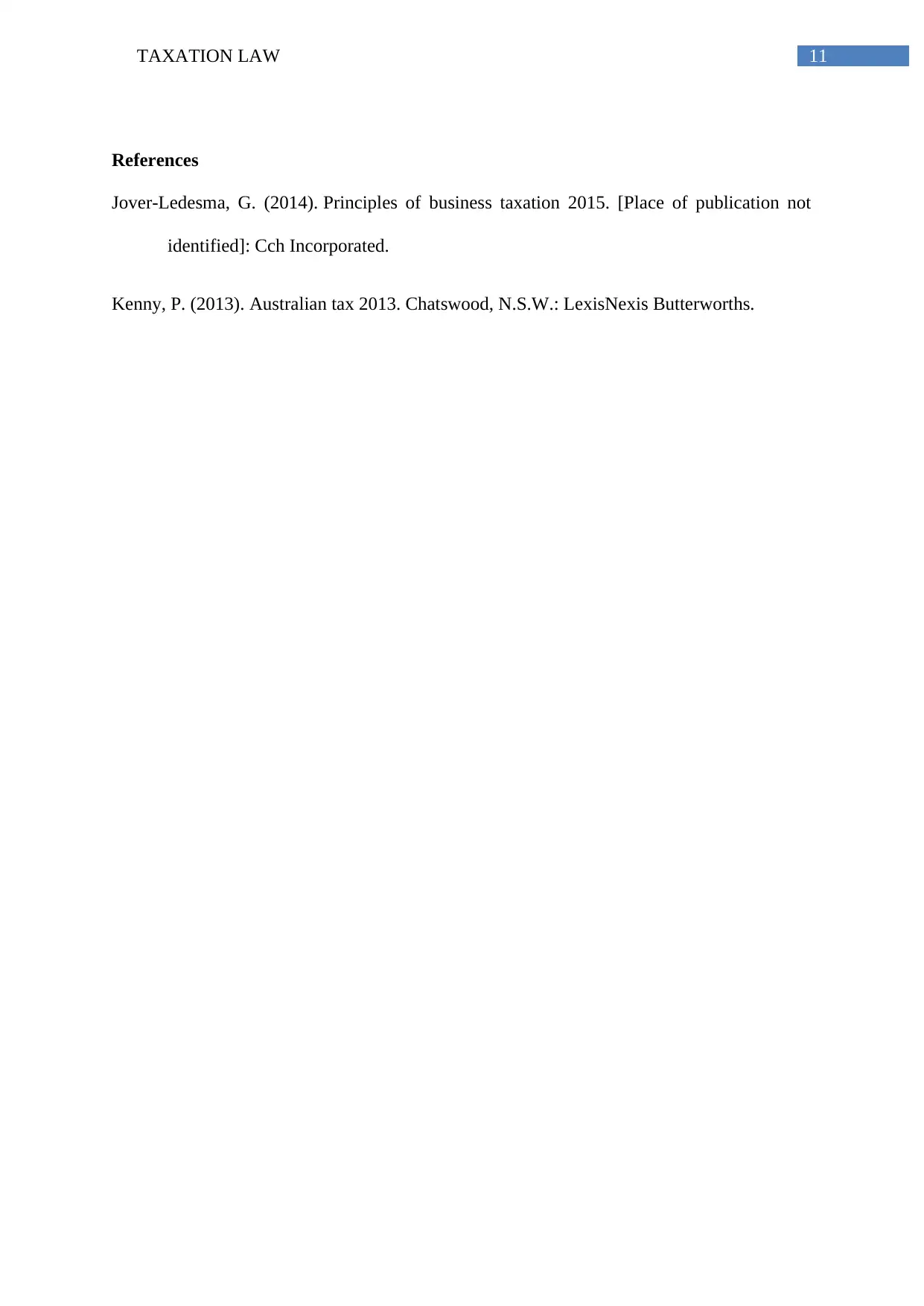
11TAXATION LAW
References
Jover-Ledesma, G. (2014). Principles of business taxation 2015. [Place of publication not
identified]: Cch Incorporated.
Kenny, P. (2013). Australian tax 2013. Chatswood, N.S.W.: LexisNexis Butterworths.
References
Jover-Ledesma, G. (2014). Principles of business taxation 2015. [Place of publication not
identified]: Cch Incorporated.
Kenny, P. (2013). Australian tax 2013. Chatswood, N.S.W.: LexisNexis Butterworths.
1 out of 12
Related Documents
Your All-in-One AI-Powered Toolkit for Academic Success.
+13062052269
info@desklib.com
Available 24*7 on WhatsApp / Email
![[object Object]](/_next/static/media/star-bottom.7253800d.svg)
Unlock your academic potential
© 2024 | Zucol Services PVT LTD | All rights reserved.





